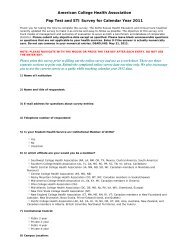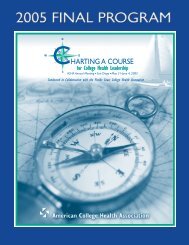Primary Prevention of Sexual Violence - American College Health ...
Primary Prevention of Sexual Violence - American College Health ...
Primary Prevention of Sexual Violence - American College Health ...
- No tags were found...
You also want an ePaper? Increase the reach of your titles
YUMPU automatically turns print PDFs into web optimized ePapers that Google loves.
Preface and AcknowledgementsPrefaceThe 2005 ACHA Campus <strong>Violence</strong> White Paper(www.acha.org/info_resources/06_Campus_<strong>Violence</strong>.pdf)stated that“…acts <strong>of</strong> violence have continued to force U.S.colleges and universities to address the dangerousand alarming violent events that send shockwavesthroughout many campuses and compromisestudents’ health and safety.”The Campus <strong>Violence</strong> White Paper also reported that“approximately 20-25% <strong>of</strong> college women are projected tobe victims <strong>of</strong> an attempted or completed rape during theircollege careers.” Further, in the Spring 2007 ACHA-National<strong>College</strong> <strong>Health</strong> Assessment, 3.9% <strong>of</strong> college women reportedattempted or actual sexual penetration against their will withinthe last academic year, 10.6% reported sexual touching againsttheir will, and 1.9% reported a sexually abusive relationship.<strong>College</strong> men reported 1.4%, 4.4%, and 1.3% on the samevariables respectively. Clearly, the challenge is upon us thatmore needs to be done to address the prevention <strong>of</strong> sexualviolence on campus.While there is a rich volume <strong>of</strong> tools, knowledge, andresources for intervention after sexual violence, the emphasis<strong>of</strong> this toolkit is to encourage prevention activities that takeplace before sexual violence has occurred and create socialchange and shift the norms regarding sexual violence. AsD. Lee, L. Guy, and B. Perry state:“To address sexual violence prevention in a trulycomprehensive manner, strategies to prevent itsinitial perpetration and victimization (primaryprevention) must reach the same level <strong>of</strong> efficacyand adoption as programs that respond to itsconsequences” (page 7).Thus, a primary prevention approach to preventing sexualviolence requires a paradigm shift in the thinking <strong>of</strong> the campuscommunity. <strong>Primary</strong> prevention helps create environments thatpromote respect, equality, civility, healthy relationships, andhealthy sexuality — and ultimately, a campus environmentwhere students are safe and learning successfully.The campus community has a stake in preventing sexualviolence and all members have a valuable role to play. Withour commitment, we can raise awareness <strong>of</strong> the primaryprevention <strong>of</strong> sexual violence within our college communities.We hope this toolkit is a start on this much needed journey.AcknowledgementsACHA would like to thank Joetta L. Carr, PhD, Pr<strong>of</strong>essor,Western Michigan University (lead consultant), Terri Kersch,MS, CHES, CWC, <strong>Health</strong> Educator, Siena <strong>College</strong>, andDonna M. Barry, RN, APN-C, Director, University <strong>Health</strong>Center, Montclair State University, for their tireless workand support <strong>of</strong> this project and especially for making thistoolkit a reality. ACHA would also like to thank the manyACHA members who provided feedback on the previousdrafts <strong>of</strong> the ACHA Position Statement on Preventing <strong>Sexual</strong><strong>Violence</strong> on <strong>College</strong> and University Campuses and this finalpublication. It would not have been possible without thefeedback, guidance, and support. Lastly, ACHA thanks theU.S. Centers for Disease Control and <strong>Prevention</strong> for its support.For additional information about this project or this toolkit,visit www.acha.org/<strong>Sexual</strong><strong>Violence</strong> or contact Robert L.Ward, MS, ACHA Project Director at rlward@acha.org.Preventing <strong>Sexual</strong> <strong>Violence</strong> on Campus• Identify social norms that support sexual violence• Strengthen sense <strong>of</strong> community• Target entire community• Link to alcohol campaigns• Use peer educators3



![Final Program [5.4MB pdf] - American College Health Association](https://img.yumpu.com/49022356/1/190x245/final-program-54mb-pdf-american-college-health-association.jpg?quality=85)












